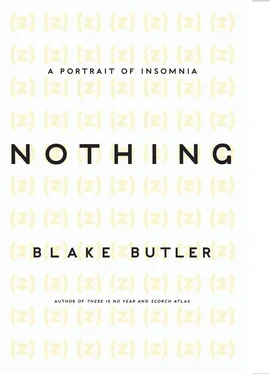Not sleeping most often does not feel transcendent, however — whatever stretch of spiritual lucidity might come over is most often accompanied by shades of aphasia, oppression, frustration, anger, ache. In the sled of not sleeping, colors lose their color, take on other colors, acquire sound. Senses learn their other senses, somewhat, if in a way complex logics in a dream might seem everyday — the intuitions or received impressions of that hidden space once pulled back into the human light again suddenly seeming far gone, or disappeared. Objects, in extended waking, seem to possess objects. Light is angry, licking your head. Communication struggles with its machinations — the speech and beeping of people and machines both softer and louder at the same time, communication’s multi-languages both more pulled open, brighter, and harder to hold in the mouth, invoke— this is not my tongue .
And yet, when charged with that idea of the other light, it is these selected spaces that can become the most terrifying when in certain lights they seem not quite what they were inside your mind — such as when being alone in a room you’ve lived in for years suddenly feels different when the light hits the walls a certain way or someone is knocking or there is sound inside the house you cannot name — or returning to a song, a place, a person you’d remembered fondly in such a way as how it’d shrouded in the mind, only to find it changed there, not yours, and even more malformed in presence in the image held in your idea of what it had once been. Fear drawn out of the familiar — instead of, say, a strange street — often feels that much more horrendous for it— this is not the place I always thought it was . The way these natured objects change (or do not change, but seem shifting inside, masked with faces you might mistake for home) in coalition with the self and its surrounding, developing a continual vortex of appropriation despite the appearance, on their outside, of permanence. Every moment up against every other moment that it is not, continually, forever — every moment never really held. The keyhole of the eye.
Meanwhile, in the body, when finally under, the effect of dreaming works in certain modes like experiencing any other kind of stress: heavy pressure on the chest, difficulty breathing, high blood pressure, a paralysis of limbs — and, in some, sleepwalking, tossing, chewing, automatism, gibberish — all mechanisms of simultaneous confinement and hyper-sound, unveiling repressed body. In some the terror might become apparent — aware of being trapped inside the self, and of being aware of being trapped, in certain angles, and of watching, from that body’s hold, as the trapping is going on — a meta-state much like that, perhaps, in claustro- and agoraphobias, or, on the other hand, the lure of autoerotic asphyxiation, smothering, and other, of a doom — of an overwhelming form impending — an approaching — other sound — new balloons. The body remains in throes desperate to communicate with the world around it, even while buried, caught between two states, fully in neither.
Between states, the body floats between the states of self — always bodied in the palpable present, but piloted with a mechanism that must coexist, and in the shift operate inside of methods that send signals between the versions — flares sent through skin. In his quasi-novel The Age of Wire and String , Ben Marcus defines the mode of snoring140 as another sleep-speech mannerism, ejected from bodies making more, or “language disturbance caused by accidental sleeping, in which a person speaks in compressed syllables and bulleted syntax, often stacking several words over one another in a distemporal deliverance of a sentence.” Marcus offers, of the nature of these disfigured words, a direct translation: “Pull me out, they say, the water has risen to the base of my neck.”141 Here the sleeping self, who will likely not remember or only remember portions of what has happened in conscious absence, can only communicate to the environment of human speaking in what seem malformed utterances, learned in life by most to drown out or disregard. The language of the self inside the self, spoken into an operant human receiver, is essentially gibberish, conducting only in its wake irritation in response to what Marcus interprets a gesture of pure fear, a metaphysical transmission of the self ’s anticipation of its own death held inside it, obliterated between fields.
In Kabbalah, such speaking might be considered employed in answering a dream question , asked of angelic escorts in the ascent of the soul: answers hidden in this product of the blank space, a furtive message. “The early medieval master Hai Gaon notes a method for attaining a dream question involving fasting, purification, and meditation on a text. Based on comments by Abraham ibn Ezra and others, scholar Moshe Idel has identified this text with Exodus 14:19–21, each verse of which contains 72 consonants alluding to a mystical series of Hebrew letters said to represent the true name of God.”142 God here, in gibberish to humans, exists among a nameless language strung in chains among a life, held in the image of the bodies of those in repose of their will. The pronouncement, perhaps not surprisingly, is similar to that anticipated in the occult, such as in Aleister Crowley’s rite of Eroto-Comatose Lucidity, from 1924:
Finally the Candidate will sink into a sleep of utter exhaustion, resembling coma, and it is now that delicacy and skill must be exquisite…. The attendants will watch with assiduity for signs of waking; and the moment these occur, all stimulation must cease instantly, and the Candidate be allowed to fall again into sleep; but no sooner has this happened than the former practice is resumed. This alteration is to continue indefinitely until the Candidate is in a state which is neither sleep nor waking, and in which his Spirit, set free by perfect exhaustion of the body, and yet prevented from entering the City of Sleep, communes with the Most High and the Most Holy Lord God of its being, maker of heaven and earth.143
The gate, from both ends in these instances, invokes the higher state of self available in which the self ceases to control, can be manipulated into seeing, at last, what had been at all times just right there — a vessel in which the self serves its own reflection — a space inside the self that extends beyond the self. Through this window, and by bringing it into the day via an insomniac state, one might find oneself in the fold of somewhere else — at last, perhaps, invoking access to those keyless, faceless rooms hidden in any day. Somewhere between want of everything and pleasure of nothing.
Or one might simply go crazy. The line between the real and unreal here grows thin. Automated in sleeplocked manner, by law an active sleeping person might no longer be responsible for his or her acts. Law has historically protected those found in unknowing operation of their bodies while committing capital offenses. Simon Fraser, of Glasgow, had recurring dreams of a monster that entered his home in his unconscious. One evening he dreamed that a white creature came up through his floor, and he beat it to death against the wood. He woke and found he’d smothered his infant son. He was acquitted, under the condition that he would thenceforth sleep only in rooms alone with the door locked.144 In 1987, Kenneth Parks, a twenty-three-year-old father, testified to having had no consciousness, to having been fully asleep, while he drove twenty-three kilometers to his in-laws’ home and murdered his mother-in-law by stabbing. Parks’s extremely unusual EEG readings, coupled with lack of obvious motive, and his testimony of knowing nothing between going to bed and arriving at a police station saying, “I think I have killed some people… my hands,” in sum led to his acquittal. In Manchester, England, in 2005, a man, Lowe, beat his father to death via a series of attacks in three unique locations of the father’s home, on different floors and on the front walk of the house, resulting in ninety different physical injuries to the body. Both were very drunk, and had gone to sleep in different rooms. Though the spread-out and repeating nature of the assault was found not consistent with usual sleep-violence behaviors, the court acquitted him of all charges.145
Читать дальше












